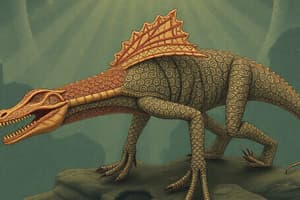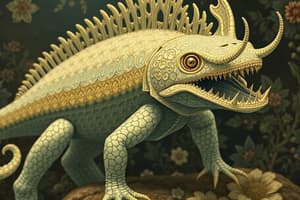Podcast
Questions and Answers
What adaptation do reptiles have to better resist desiccation?
What adaptation do reptiles have to better resist desiccation?
- Moist skin surface
- Thin stratum corneum
- Dense blood vessel network
- Highly keratinized cells (correct)
What is a characteristic feature of the epidermis in reptiles?
What is a characteristic feature of the epidermis in reptiles?
- Horny scales (correct)
- Feathers
- Mucus glands
- Hair follicles
What purpose do the granular glands in toads serve?
What purpose do the granular glands in toads serve?
- Aid in breeding
- Assist in locomotion
- Secrete moisture
- Defensive secretion (correct)
In snakes, what modification do scales on the ventral surface undergo?
In snakes, what modification do scales on the ventral surface undergo?
How can the age of turtles be determined?
How can the age of turtles be determined?
What modification is seen in the tails of rattlesnakes?
What modification is seen in the tails of rattlesnakes?
Which is NOT a characteristic found in the stratum corneum of reptiles?
Which is NOT a characteristic found in the stratum corneum of reptiles?
What type of environment does the epidermis of reptiles ultimately adapt to?
What type of environment does the epidermis of reptiles ultimately adapt to?
What characterizes the notochord in its early development?
What characterizes the notochord in its early development?
What is one of the primary functions of the vertebral column?
What is one of the primary functions of the vertebral column?
How does the vertebral column provide flexibility?
How does the vertebral column provide flexibility?
What primarily comprises the notochord?
What primarily comprises the notochord?
Which of the following is NOT a characteristic of the vertebral column?
Which of the following is NOT a characteristic of the vertebral column?
What characterizes the structure of horns?
What characterizes the structure of horns?
Which statement accurately describes antlers?
Which statement accurately describes antlers?
What type of glands aid in heat regulation and are associated with hair?
What type of glands aid in heat regulation and are associated with hair?
What is a key feature of rhinoceros horns?
What is a key feature of rhinoceros horns?
Which type of gland secretes cerumen in the outer ear?
Which type of gland secretes cerumen in the outer ear?
Which of the following statements about epidermal glands is correct?
Which of the following statements about epidermal glands is correct?
What describes the classification of glands based on their structure?
What describes the classification of glands based on their structure?
Which type of gland is absent in pangolins and echidnas?
Which type of gland is absent in pangolins and echidnas?
What structure is formed by the left and right laminae of bone in relation to the spinal cord?
What structure is formed by the left and right laminae of bone in relation to the spinal cord?
In which group does the persistence of the notochord occur with no centra developed?
In which group does the persistence of the notochord occur with no centra developed?
Which cartilage is associated with the notochord and is described as being 'in between'?
Which cartilage is associated with the notochord and is described as being 'in between'?
What is the significance of the hypocentrum in early vertebrate evolution?
What is the significance of the hypocentrum in early vertebrate evolution?
Which group of vertebrates is characterized by having an enlarged pleurocentrum?
Which group of vertebrates is characterized by having an enlarged pleurocentrum?
What feature characterizes the intercentrum in various vertebrate groups?
What feature characterizes the intercentrum in various vertebrate groups?
What distinguishes the Stereospondyli group of vertebrates from their ancestors?
What distinguishes the Stereospondyli group of vertebrates from their ancestors?
What cartilage is positioned dorsally and is characterized as 'basic dorsal'?
What cartilage is positioned dorsally and is characterized as 'basic dorsal'?
Which evolutionary lineage is noted for having bones in several segments?
Which evolutionary lineage is noted for having bones in several segments?
What is true regarding the cartilages associated with the notochord?
What is true regarding the cartilages associated with the notochord?
What is the primary reason living reptiles such as birds and opossums have more cervical vertebrae than mammals?
What is the primary reason living reptiles such as birds and opossums have more cervical vertebrae than mammals?
Which characteristic is unique to the synsacrum in birds?
Which characteristic is unique to the synsacrum in birds?
What distinguishes the vertebrae of mammals from those of reptiles when it comes to mobility?
What distinguishes the vertebrae of mammals from those of reptiles when it comes to mobility?
How many cervical vertebrae do most mammals have?
How many cervical vertebrae do most mammals have?
Why might a giraffe have a relatively small number of cervical vertebrae compared to its neck length?
Why might a giraffe have a relatively small number of cervical vertebrae compared to its neck length?
What is the significance of stout transverse processes in the sacral vertebrae of bears?
What is the significance of stout transverse processes in the sacral vertebrae of bears?
Which of the following describes the sacral vertebrae of amphibians?
Which of the following describes the sacral vertebrae of amphibians?
How many fused sacrals and caudals do armadillos have in their synsacrum?
How many fused sacrals and caudals do armadillos have in their synsacrum?
What feature limits the flexibility of the avian backbone caudal to the neck?
What feature limits the flexibility of the avian backbone caudal to the neck?
Which of the following mammals is an exception to the typical number of cervical vertebrae?
Which of the following mammals is an exception to the typical number of cervical vertebrae?
Flashcards are hidden until you start studying
Study Notes
Sarcopterygians
- Dipnoans, chondrostei, and coelacanth develop no centra.
- Notochord is present and unconstricted.
- Notochord sheath contains little cartilage or bone.
- Basidorsal, basiventral, interdorsal, and intervertebral cartilages associated with the notochord.
Evolution of Tetrapod Vertebrae
- Rhipidistians and early labyrinthodonts consisted of several bones per segment.
- Hypocentrum is a median, U-shaped anterior bone that cradled the notochord.
- Pleurocentra are small wedges of bone overlying the notochord dorsolaterally.
- Laminate of bone, lateral to the spinal cord, collectively form a neural arch.
Rhachitomi
- Large intercentrum and a small pleurocentrum.
- Considered to be the ancestor.
Stereospondyli
- Retained only the intercentrum.
- Older descendants
Embolomeri
- Increased size of pleurocentrum to the size of the intercentrum.
- Dual centra are seen.
Amniotes
- Enlarged pleurocentrum to near or complete exclusion of the intercentrum.
- Intercentrum is eliminated.
Integumental Adaptations
- Show advanced integumental adaptations to the terrestrial environment.
- Cells are more highly keratinized.
- Integument is modified into horny scales in snakes and lizards.
Epidermis of Reptiles
- Ultimate adaptation of craniate skin for surviving in an arid environment.
- Horny scales, scutes, beaks, rattles, claws, plaques and spiny crests are found in the stratum corneum.
Granular Glands
- Present in toads.
- Secrete irritating alkaloids substances which are defensive in nature.
Keratin
- Aquatic urodeles have thin desiccation-impending stratum of cornified cells.
Horns
- Permanent.
- Have bone inside then covered by the skin.
- Not shed.
- Surrounding the bony core is a highly keratinized layer of epidermis.
Antlers
- Not present throughout the year.
- Shed during non-breeding season.
- Develop a protective covering of skin - velvet.
Mucous Glands
- Lost significance due to the cornification of skin.
- Absent in tetrapods except in mammals.
Sebaceous Glands
- Associated with hair.
- Present when there are hairs and sebum is exuded into hair follicles.
- Aid in heat regulation.
- Ceruminous glands secrete cerumen (wax) in the outer ear.
- Ceruminous glands give off scents.
- Meibomian glands assist in lubrication of the conjunctiva of the eye.
Sudoriferous or Sweat Glands
- Present in furry animals in areas like the feet, lips, and the sides of the head.
- Absent in pangolins, sirenians, cetaceans, and echidnas.
Vertebral Column
- Segmented, more or less flexible, arched rod flanked by axial musculature.
- Function: Suspends the trunk, holds the trunk in either upright or transverse position.
- The mineralization of the notochord.
Cervical Vertebrae
- Increased number of cervical vertebrae allows for more movement.
- Commonly 12.
- Can reach 25 in swans.
Transverse Processes
- Living reptiles, most birds, and opossums have 2 transverse processes.
- Most mammals have 3 to 5 (ankylosed).
- Perissodactyls can have up to 8.
- Edentates can have up to 13.
Synsacrum
- Special type of vertebra.
- Fusion of the last thoracic, all lumbars, sacrals and the first few caudals with the pelvic girdle.
- Provides rigid brace for the stance of birds.
- Little flexibility in the avian backbone caudal to the neck.
Sacral Vertebrae
- Bears hold stout transverse processes to bear the thrust of the pelvic girdles.
Caudal Vertebrae
- Early tetrapods usually had 50 or more.
- Amphibians have only 1 transverse process in the sacral vertebra.
Studying That Suits You
Use AI to generate personalized quizzes and flashcards to suit your learning preferences.




